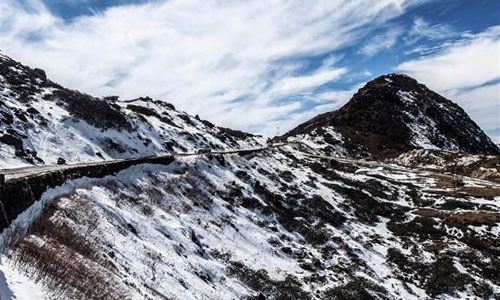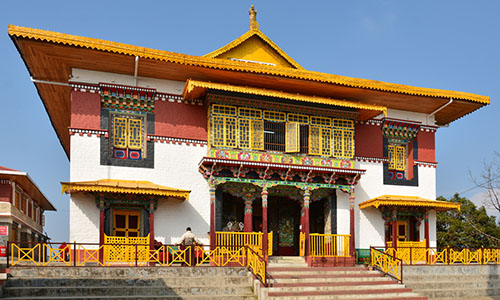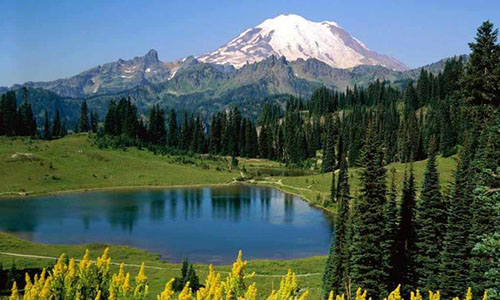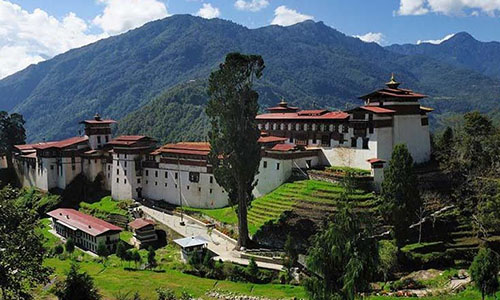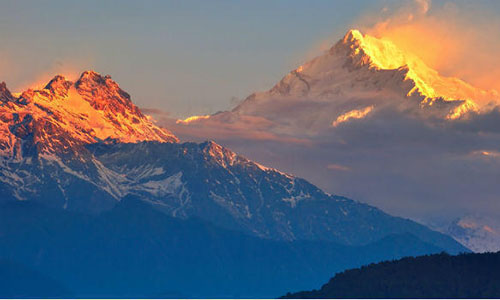Darjeeling
“Queen of The Hills”
Darjeeling Tourism-A Glimpse
 Household name because of its varieties of teas, Darjeeling is a hill station with vast expanses of tea estates and Tibetan influence in their craft, culture and cuisine.
Household name because of its varieties of teas, Darjeeling is a hill station with vast expanses of tea estates and Tibetan influence in their craft, culture and cuisine.
A previous summer capital of India under the British Raj, Darjeeling has come off age as one of the most sought after hill stations in India. Famous for its beautiful tea plantations and the quality of Darjeeling tea, Darjeeling is a delight for all kind of tourists. The toy train established back in 1881, still runs in this part and is also one of the UNESCO World Heritage sites. Beautiful colonial architecture including mansions and churches dot this little beautiful town. Filled with people from Tibet, Nepal, nearby Indian states and the Gorkhas, Darjeeling is brimming with cultural diversity. The third highest peak in the world and the highest in India, the Kanchenjunga peak is clearly visible from here and you can enjoy a panoramic view of the peak. Some of Darjeeling’s most popular attractions include monasteries, botanical gardens, a zoo, and the Darjeeling-Rangeet Valley Passenger Ropeway cable car which happens to be the longest Asian cable car. Darjeeling is a wonderful place to walk around and explore the tea estates, villages, and markets.
What’s Great?
Close to Siliguri which is well connected by rail and air. Excellent view of Kanchenjunga. Colonial heritage. Good food, of course.
What’s not so Great?
Slightly congested and traffic jams. Gets crowded in peak seasons.
Darjeeling Tea Tourism
Popularly known as the “Mecca of Tea”, Darjeeling is leading in the area of tea tourism. With 80 operational tea gardens, sprawling across acres of land, Darjeeling produces what is known as the “Champagne of tea”. This place is all about spending a few days in a sprawling tea garden, in a Bungalow that was typically the residence of a former British tea planter. Located on top of the hills amidst cool winds and misty weather, Darjeeling gives you an experience like no other. Imagine waking up in the middle of lush tea gardens, sipping a cup of finest aromatic tea, taking a stroll through the gardens and talking to the garden workers learning about their life. Ultimate, isn’t it? That’s Darjeeling tea tourism for you.
Darjeeling has numerous places to learn about tea production. The busiest time is from March to May, but occasional plucking occurs from June to November. Also, there is no plucking on Sunday. You can go for a homestay with a tea- picker’s family and you’ll get to join your hosts for the morning work in the tea bushes. You can return home with a batch of your very own hand-plucked Darjeeling tea.
History of Darjeeling
The name Darjeeling means the “the land of the thunderbolt”, derived from the Tibet word “Dorje” meaning ‘thunder’ and “ling” meaning ‘piece of land’. Prior to its acquisition by East India Company, Darjeeling used to be a part of Sikkim and even before that, a part of Nepal. In February 1829, a dispute broke out between Nepal and Sikkim about their borders and hence, Lord William Bentinck- Governor General of India at the time, set out to resolve the situation. In the process, he realised that the quaint hill town had strategic advantages for trade and military outpost. Later, it was also realised that the land was ideal for tea plantations. The district underwent major development and became a major tourist attraction visited by the British officials. It, therefore, earned itself the title of “Queen of Hills”. After independence, the district was merged with West Bengal and since then is one of the most popular hill stations in India.
Culture of Darjeeling
Darjeeling has a unique and diverse culture. The city is a home to mix immigrants from Nepal, Sikkim, Tibet, Bhutan and even Europe, due to work opportunities in tea plantations in the bygone era. Hinduism and Vajyarana Buddhism are the main religions of the people. One of the major festivals of Darjeeling is Losar, primarily their new year, which is celebrated in January or February depending on the position of the moon (lunar calendar). Darjeeling Carnival is another major festival held annually. The fair involves a display of folk dance and arts. Local rock bands participate in the same. Other important festivals are Makar Sankranti, Chotrul Duchen (Buddhist festival commemorating the four events in the life of Gautam Buddha), Tendong Lho Rumfaat (Prayer of the Tendong mountain) etc.
Flora and Fauna
Darjeeling is a paradise on Earth with its luxuriant green forest of deciduous and evergreen trees, and appealing natural habitat. It houses over four thousand species of plants, three hundred varieties of ferns, six hundred species of birds, and loads of mammals and wild animals. You can find trees such as chestnut, cherry, sal, birch, oak, elm, a lot of wet alpine tress and fine rare orchids. Rhododendron also grows on the hills. It is also home to myriad birds including woodpeckers, orioles, sunbirds, flycatchers, finches, Bengal florican and herons etc. A large number of animals can be found too like tiger, leopard, hog deer, one-horned rhinoceros etc.
Restaurants and Local Food in Darjeeling
Darjeeling has a delectable, scrumptious cuisine. Darjeeling is full of choices ranging from Bengali cuisine, Tibetan cuisine, South Indian items, Naga cuisine, Nepali food to Continental, Chinese as well as Tandoori delicacies. Essentially the food here has distinct traces of Bengali, Nepali and Tibetan elements.
In spite of such wide choices, one of the first items on the cuisine here includes the finest and freshest qualities of tea found in the area which you must try. The popular items that you must indulge in include Momos, Thukpa, Aloo Dum, Sael Roti, Naga Platter, Nepali thali, Tongba, Channg and many more. Not to mention, tea is a popular beverage consumed by all.
Do not forget to spend a day in at least one of the adjacent hill stations near Darjeeling and the list includes beautiful towns like Kalimpong, Kurseong or Mirik.
Kalimpong Tourism
Kalimpong is a virgin hill station in West Bengal renowned for its panoramic valley views, Buddhists monasteries and churches and Tibetan handicrafts etc. 50 minutes east of Darjeeling, Kalimpong is a hill station on the foothills of Shivalik ranges at an altitude of 1250 m overlooking the Teesta Valley. People say that the area was ruled by Bhutanese kings and was a forward post of the Bhutanese Army till the 19th century. Dotted with ancient Buddhist monasteries, centuries old churches and exquisite revered temples Kalimpong marks the Bhutanese history till it was wrested by British rulers. The Jang Dong Palriffo Brang (Monastery), Thongsa Gompa (Bhutanese Monastery) are some famous places to visit. Also make sure to visit the flower markets famous for its orchids and lovely bright flowers.
“The Land of White Orchids-Kurseong”
Also known as the ‘Land of White Orchids’, Kurseong is a hill station located close to Darjeeling famous for its waterfalls, temples and Buddhist gompas, apart from the excellent view that the place provides.
Perched on the Siliguri-Darjeeling highway, Kurseong is a quiet hill station. Kurseong enjoys milder and pleasant weather most times of the year. During the monsoon season the rain-gods are more than generous as the town receives non-stop rains for days. The rains are in fact much needed for the flora and fauna of the area. Kurseong, the ‘Land of White Orchids’, gets its name from the flowers found in abundance on its hill-slopes. It isdifficult not to fall in love with the view of tea plantations, lush green forests in the panoramic setting of snow-clad mountains. At sunset, you can see an amalgamation of the most beautiful colors in the sky. You can see the British remnants in the form of churches and school in the town. This small hill-town makes for a great stopover for tourists looking for a more peaceful alternative to Darjeeling.
“The Valley of the Sun-Mirik”
Located on the banks of a huge lake, the hill town of Mirik adds to North Bengal’s bounty. Amidst the Himalayan Valley, Mirik has more to offer than just beautiful mountains and lakes.
From boating experiences for your romantic getaway to temples for the faithful to orchids and gardens for the nature’s child, West Bengal tourism is incomplete without Mirik. The well-populated, yet not over crowded town also offers viewpoints for those quiet moments of introspection as well as traditional Indian Bazaars to splurge. Going to Mirik for the perfect hill station getaway is an idea you’ll never go wrong in.
Other Trips
These are other trips.





